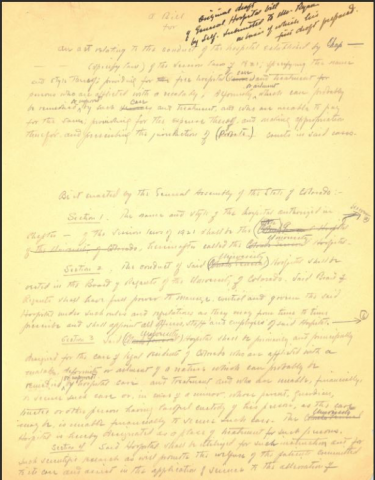Dr. Charles Meader began the work to build the University of Colorado Health Sciences Campus at 9th and Colorado after the University had gone through a long history of moving back and between from Boulder to Denver.
In 1879, the Regents of the University of Colorado issued an announcement saying ‘The object of the establishment of this Department [of Medicine] is to secure a good medical education for those who may in the future be entrusted with the lives and with the health of our citizens. The Regents believe that the lives and health of the people of Colorado are not second in importance to another interest that can be subserved by the State University. The Medical Department of the University, like the other Departments of this institution, assumes no unjustifiable superiority over colleges. It aims to emulate the best school, but chooses to establish its own standard. The State of Colorado, through the Medical Department of its State University, offers no facile inducements to graduation, but proposes to serve the best interest of the citizens of the State.’
This began the University of Colorado Department of Medicine. When it was instituted in 1883, it was originally housed in two rooms of CU’s Old Main and a 30 bed teaching hospital in Boulder. Budget problems, the small size of the hospital, and pressure to compete with other medical schools in Denver, such as the Denver and Gross College of Medicine, prompted the medical school to move, in part, to Denver.
All the clinical work the students did was moved to Arapahoe County Hospital (later Denver General) in 1893. However, the Colorado Supreme Court ruled that all students of the University of Colorado had to be taught in Boulder, so the clinical side of the school was moved back in 1897.
In 1910, the rules were changed, and the clinical curriculum was able to legally move back to Denver. The school was housed at the James B. Archer Mansion at 1301 Welton St. from 1911 to 1924. Dean Meader began working on the acts to incorporate the teaching and clinical work of the health sciences programs as soon as he became Dean, in 1916.

